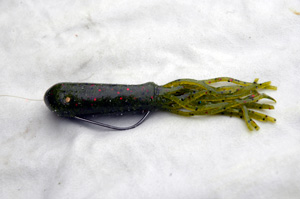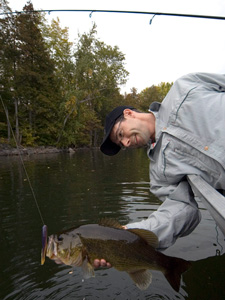
I watched and waited. My line twitched once, then started to move. I had just skipped a purple tube under a long dock and a largemouth bass quickly decided it was dinner. I set the hook, feeling the weight of a decent fish. The largemouth swam towards the dock's pillars with a strong surge, but the rod's steady pressure coaxed the fish boat side. I lipped the hefty largemouth and got a photo before releasing the fish.
 |
| Skipping allows you to make accurate casts to tight, otherwise inaccesible fish-holding areas. |
I watched and waited. My line twitched once, then started to move. I had just skipped a purple tube under a long dock and a largemouth bass quickly decided it was dinner. I set the hook, feeling the weight of a decent fish. The largemouth swam towards the dock's pillars with a strong surge, but the rod's steady pressure coaxed the fish boat side. I lipped the hefty largemouth and got a photo before releasing the fish.
"Another one fooled by a skipped bait," I said to my fishing partner as I rigged another tube. "It gets better, we've got a lot more docks to fish before our day's over," he enthusiastically replied. That day, we caught several bass by skipping tubes, and this season you can too if you take the time to learn this presentation. Here's what you need to know.
Why You Should Skip Tubes
Bass hold under cover-laden areas to escape the sun, predators and fishing pressure and typical holding areas include docks, boat houses, pontoon boats, laydowns and overhanging branches. For many, flipping or pitching is the preferred method to fish these kinds of cover. The underhand, pendulum approach of these casting styles presents the bait straight on and from above. Although accurate and precise, the casts' mechanics can have limitations around overhanging obstacles. This is when the low trajectory and small angle allowed by skipping tubes gives you an advantage.
For example, picture yourself at a long dock with boats on either side. If flipping, you'd be limited to how much of the dock you could fish and you'd likely only be able to access the periphery. The ropes securing the boats would be obstacles, and couldn't flip beyond them, at least not without taking your chances at snagging the line.
But that same dock can be thoroughly fished by skipping tubes. With a little practice, accurate casts could let you bounce a tube under the ropes and around the boat. You could also skip a tube a considerable distance through the dock's main opening, accessing water probably off limits to flipping.
Done properly, skipping causes minimal splash and you can skip baits from a far. This makes it a good option in clear, shallow water. Bass appear attracted to the skipped tube as it mimics the fleeting tactics of baitfish or something scurrying across the water.
Rigging Tubes for Skipping
 |
| To keep tubes snag resistant, rig them Tex-Posed using a 2/0 to 3/0 wide gap hook, matching hook size to the tube's body. |
When skipping stones, the best rocks are flat and smooth. The same logic applies to the sleek, rounded profile of tubes. To keep tubes snag resistant, rig them Tex-Posed using a 2/0 to 3/0 wide gap hook, matching hook size to the tube's body. As skipping is an abusive presentation, use tubes with tough plastic noses to hold hooks in place.
You'll want to add weight to tubes to cast them with enough force so they skip and then sink upon entry. Use weighted hooks or simply insert a weight into the tube. You can use weights specifically designed for tubes or insert a worm weight between 1/16 to 1/4 ounce into the tube's body. With a worm weight insert a tooth pick horizontally, and behind it, to peg it in place. Another alternative is using a bell sinker in combination with Eagle Claw High Performance Hook. Stuff the sinker in the tube, then rig the bait ensuring you pass the hook point through the bell sinker's eye. Once rigging is complete, fasten the hook's patented clip to hold the plastic and sinker in place.
The weight's location on the tube will influence its underwater action. A front-weighted tube will nose dive in a tight spiral, while a center-weighted one will shimmy or glide in a larger circle in a horizontal position.
The Gear You Need
I recommend skipping with a spinning outfit. Spinning reels' stationary spools let line unravel without tangles from the irregular surge-and-bounce pull of line from a skipping bait. You'll want to use 12- to 17-pound-test fluorocarbon or 20- to 30-pound-test braid for their strength and abrasion resistance. Fluorocarbon is virtually invisible in the water, making it the better choice for clear lakes.
When it comes to rods, you can skip a tube with any length of stick; however, shorter rods provide more manoeuvrability around docks. I use a 5'4" G. Loomis (SJR642) spinning rod specifically designed for skipping baits. It has a fast tip that loads with a snap of the wrist, and unloads quickly enough to propel tubes. It also has enough backbone to pull bass from cover.
How to Skip a Tube
To skip a tube, start with 6 to 12 inches of line between your rod tip and the bait. Begin a side arm cast and point the rod tip slightly downward, keeping both hands on the rod to improve casting accuracy and control. With a quick turn of the wrist, spin the tube on the line so that it rotates around the rod tip in a clockwise motion. This manoeuvre adds momentum to the tube. You can skip tubes without this first step, but I find it improves my casting distance.
Immediately after starting to spin the tube, pull back on the rod and begin a side arm cast. As the tube completes half a rotation, snap the rod tip forward. In an ideal cast, the rod tip should unload as the tube completes 3/4 of the rotation.
 At this point the bait should shoot forward at a low angle along the water. If the angle is too high, the tube will likely sink, make a big splash, or bounce on too high of an arc to bounce again.
At this point the bait should shoot forward at a low angle along the water. If the angle is too high, the tube will likely sink, make a big splash, or bounce on too high of an arc to bounce again.
If having difficulty keeping baits low, consider crouching, as a low trajectory is critical to this technique. Think of the perfect stone skip. The rock hops along the water in a series of small, tight splashes before sinking. Replicating this type of skip with a tube will result in controlled casts and subtle splashes. The splashes slow the bait down, and once the tube loses most its momentum it will faintly sink. This type of cast is perfect for getting under docks with minimal space between them and the water.
When penetrating leafy branches dangling in the water, you want a slightly higher skipping angle. Aim the tube in front of the branches so that it breaks through the leaves after the first bounce. To get a higher bounce, either raise the rod tip slightly so the bait hits the water at a higher angle, or keep the bait low but add a stronger snap to your cast so that the tube skips high off the water.
In most instances, the bounce and resistance of the tree's leaves slow the bait down so that the tube's entry has a small splash. Let the bait rest for several seconds to see if any bass are holding under the tree, then give it a few slow pulls. If there aren't any takers, swim the bait from the cover to avoid catching the branches.
Skipping requires calm or ripple water conditions. You can't skip rocks well in rough water and the same applies to tubes. The technique also demands accuracy. As you learn this method, use open water and practice. The mechanics will come through the repetition as will confidence and casting precision. Your reward will come when you lip a bragging-sized bass after threading a tube through the 8-inch clearance offered between the water and a dock! Learning this casting technique gives you one more tool for your angling arsenal. Who knew that the fun and the skills of that childhood game of bouncing stones would transfer to skipping tubes for largemouth bass?
- 12014 views

